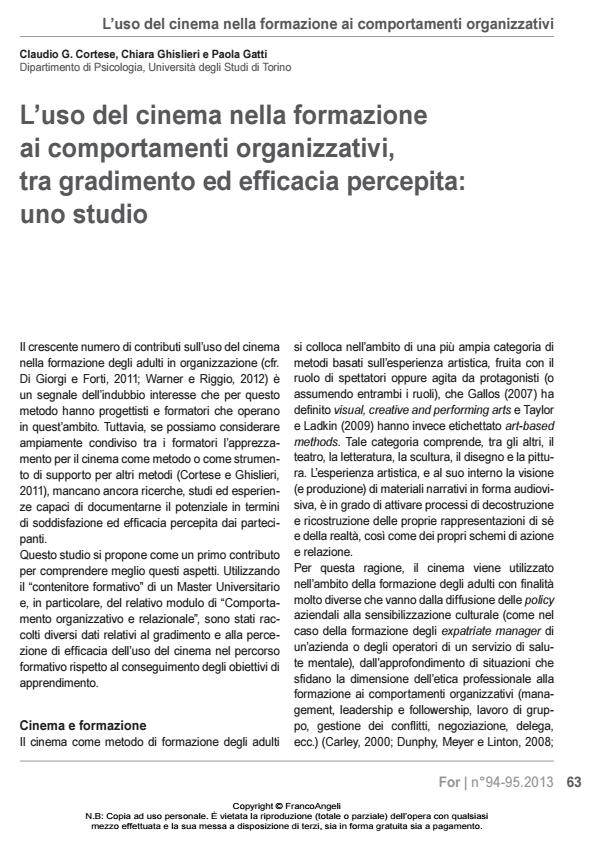L’uso del cinema nella formazione ai comportamenti organizzativi, tra gradimento ed efficacia percepita: uno studio
Titolo Rivista FOR Rivista per la formazione
Autori/Curatori G. Claudio Cortese, Chiara Ghislieri, Paola Gatti
Anno di pubblicazione 2014 Fascicolo 2013/94-95 Lingua Italiano
Numero pagine 7 P. 63-69 Dimensione file 665 KB
DOI 10.3280/FOR2013-094013
Il DOI è il codice a barre della proprietà intellettuale: per saperne di più
clicca qui
Qui sotto puoi vedere in anteprima la prima pagina di questo articolo.
Se questo articolo ti interessa, lo puoi acquistare (e scaricare in formato pdf) seguendo le facili indicazioni per acquistare il download credit. Acquista Download Credits per scaricare questo Articolo in formato PDF

FrancoAngeli è membro della Publishers International Linking Association, Inc (PILA)associazione indipendente e non profit per facilitare (attraverso i servizi tecnologici implementati da CrossRef.org) l’accesso degli studiosi ai contenuti digitali nelle pubblicazioni professionali e scientifiche
- Agosti A. (a cura di) (2004). Il cinema per la formazione. Argomentazioni pedagogiche e indicazioni didattiche. Milano: Franco Angeli
- Armstrong S.A., Berg R.C. (2005). Demonstrating Group Process Using 12 Angry Men. Journal for Specialists in Group Work, 30(2), 135-144
- Taylor S.S., Ladkin D. (2009). Understanding arts-based methods in managerial development. Academy of Management Learning & Education, 8(1), 55-69
- Berger M., Bossert S., Krieg J., Dirlich G., Ettmeir W., Screiber W., von Zerssen D. (1987). Interindividual differences in the susceptibility of the cortisol system: An important factor for the degree of hypercortisolism in stress situations?. Biological Psychiatry, 22(11), 1327-1339
- Burke L.A., Hutchins H.M. (2007). Training Transfer: An Integrative Literature Review. Human Resource Development Review, 6(3), 263-296
- Carley M.S. (1999). Training go to the movies. Training & Development, 7, 15-18
- Champoux J.E. (1999). Film as a teaching resource. Journal of Management Inquiry, 8(2), 240-251
- Champoux J.E. (2001a). Animated films as a teaching resource. Journal of Management Education, 25(1), 79-100
- Champoux J.E. (2001b). Management: Using Film to Visualize Principles and Practices. Cincinnati, OH: South-Western
- Champoux J. E. (2001c). Organizational Behavior: Using Film to Visualize Principles and Practices. Cincinnati, OH: South-Western
- Cortese C.G., Ghislieri C. (2011). Il cinema e YouTube. In: D. Boldizzoni, R.C.D. Nacamulli (a cura di) Oltre l’aula, Milano: Apogeo, 219-244
- Di Giorgi S., Forti D. (2011). Introduzione. Formare con il cinema. Ieri, oggi, domani. In: S. Di Giorgi, D. Forti (a cura di) Formare con il cinema. Milano: Franco Angeli, 15-66
- Dunphy S., Meyer D., Linton S. (2008). The top 10 greatest screen legends and what their definitive roles demonstrate about management and organizational behaviour. Behaviour & Information Technology, 27(2), 183-188
- Gallos J.V. (2007). Artful Teaching: Using the Visual, Creative and Performing Arts in Contemporary Management Education. In: S. Armstrong, C. Fukami (a cura di), Handbook of Management Learning, Education and Development. Thousand Oaks:
- Sage Gegenfurtner A., Veermans K., Festner D., Gruber H.
- (2009). Motivation to Transfer Training: An Integrative Literature Review. Human Resource Development Review, 8(3), 403-423
- Grimand A. (2009). Fiction, culture populaire et recherché en gestion. Une exploration croisée à travers la série Les Simpsons. Revue Française de Gestion, 194, 169-185
- Holbrook R. L. (2006). Art Imitates Life: Using Movies and Music in Organizational Behavior. New York: Wiley.
- Holbrook R.L. (2007). Art Imitates Life: Using Movies and Music in Principles of Management. New York: Wiley.
- Holbrook R.L. (2009). OB in a Video Box. Using Remember the Titans as a microcosm for the organizational behavior course. Journal of Management Education, 33(4), 490-451
- Huczynski A., Buchanan D. (2004). Theory from fiction: A narrative process perspective on the pedagogical use of feature film. Journal of Management Education, 28(6), 707-726
- Islam G. (2009). Animating leadership: Crisis and renewal of governance in 4 mythic narratives. The Leadership Quarterly, 20(5), 828-836
- Kernodle T. (2009). Effective media use: Using film and television to instruct an organizational behavior course. American Journal of Business Education, 2(8), 37-49
- Mallinger M., Rossy G. (2003). Film as a lens for teaching culture: Balancing concepts, ambiguity, and paradox. Journal of Management Education, 27(5), 608-624
- Seyforth S.C., Golde C.M. (2001). Beyond the paper chase: Using movies to help students get more out of college. About Campus, 6, 2-9
- Smith G.W. (2009). Using feature films as the primary instructional medium to teach organizational behaviour, Journal of Management Education, 33(4), 462-489
- Varchetta G. (2011). Pensare, apprendere al cinema. In: S. Di Giorgi, D. Forti (a cura di) Formare con il cinema. Milano: Franco Angeli, 69-92
- Warner N.O., Riggio R.E. (2012). Italian-American leadership in Hollywood films: Images and realities.
- Leadership, 8(3), 211-217 Zull J.E. (2002). The art of changing the brain: Enriching the practice of teaching by exploring the biology of learning. Sterling, VA: Stylus
G. Claudio Cortese, Chiara Ghislieri, Paola Gatti, L’uso del cinema nella formazione ai comportamenti organizzativi, tra gradimento ed efficacia percepita: uno studio in "FOR Rivista per la formazione" 94-95/2013, pp 63-69, DOI: 10.3280/FOR2013-094013